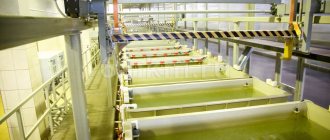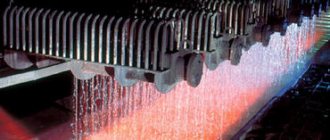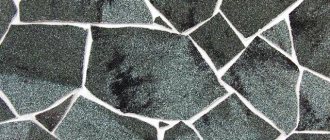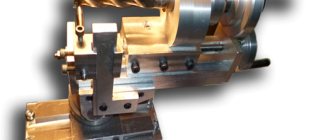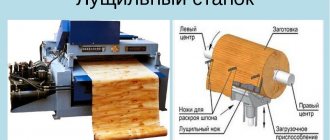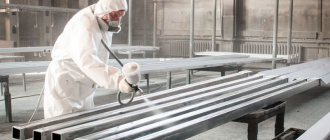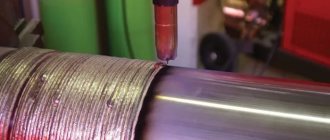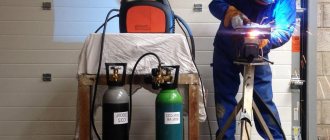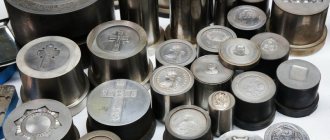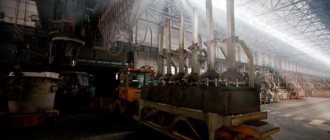Purpose of the galvanic method
Electroplating of metal on the surface is used to give them the properties of a specific material (silver, gold, nickel, etc.). Or if it is impossible to make an item from this material, and also if the price is unreasonably high.
For example, the application of chromium imparts hardness and anti-corrosion properties to plain steel. This technology was widely used to coat parts and mechanisms of machine tools. Chrome, in addition to being hard, gives a mirror-like shine and provides good protection against corrosion. Chrome is a hard but brittle metal, and it is not possible to manufacture parts and objects from it. Applying it to the surface by electroplating is a good alternative, as well as the opportunity to use the properties of chromium in everyday life.
The galvanizing process is carried out in special baths. An electrolyte containing salts of the metal that is deposited on the surface of the workpiece is poured into it. Compared to other methods, electroplating technology has advantages. When using, for example, a spray gun or other spraying devices (many organizations pass off this method of metallization as electroplating), it is impossible to achieve a perfectly even coating, high-quality adhesion and obtain the properties of metal on the surface. Usually, a non-conductive polymer layer is applied by spraying, in other words, paint, or a thin silver layer (for the reaction of a silver mirror, see the school curriculum), and on top is a transparent or colored varnish. The electroplating process makes it possible to obtain a uniform, dense, well-adhesive coating that has all the properties of the deposited metal.
Electroplating Shop Harmful to Humans
Coating of metals by electrodeposition
from aqueous solutions of metal salts occupies one of the prominent places among metal coatings. Electrodeposition processes are carried out in devices called electrolyzers or galvanic baths. An aqueous solution of acidic salts (nickel sulfate, zinc sulfate, copper sulfate) or alkaline complex salts (cyanide compounds of copper, zinc, cadmium, silver, gold) of metals poured into baths is called an electrolyte. Electric current is introduced into the electrolyte through carbon or metal electrodes, usually in the form of rods or plates.
Even small concentrations of chromic anhydride
in the air can cause more or less significant damage to the nasal mucosa. Gasoline, chlorinated hydrocarbons and kerosene used to degrease products can also have an effect on the skin. Cases of hydrogen cyanide poisoning in galvanic shops, both acute and chronic, are observed extremely rarely - when acidic solutions of salts and cyanide alkaline electrolytes are accidentally spilled on the floor and mixed, if the acid and alkaline baths are located adjacent and do not have separate drains within the workshop for electrolytes that fall on the floor.
The consequences that you read about in the previous paragraph do not necessarily appear if you follow preventive measures and organize production correctly. Firstly, it is necessary that the premises in which the workshops are located should, if possible, be one-story. All rooms must be as isolated as possible, and they must have a good ventilation system, which is especially important in production that pollutes the air. In addition, the workshop structure must be planned in such a way that the equipment makes up no more than 20% of its premises. It is necessary to have passages and passages so as not to create obstacles during the work process.
It is no secret that working in a galvanic shop is associated with health hazards. That is why the state provides social guarantees for workshop workers. For example, for workers dealing with chrome and copper plating of shafts, state pensions are provided on preferential terms and in preferential amounts.
Passages in tunnels and galleries must be separated from busbars by metal mesh with holes no larger than 20x20 mm. The width of the passage should be 1.0 m between the wall and the fence with one-sided tires and 1.2 m between two fences with two-sided tires.
We recommend reading: State duty when filing a claim Application for Cancellation of Alimony Sample
Immersion of parts into baths and removal from them must be done under stress-free conditions. Products should be lowered into the solution and removed from it only with tongs or on hangers smoothly, avoiding splashing of the electrolyte. Small items are immersed in the solution in steel wire baskets.
The essence of the technological process
Electroplating is used to produce thick technical and thin decorative layers of metal. The functions of electroplating are determined not by the layer that is applied to the surface, but by its characteristics: thickness, sublayer, preparation (etching, polishing).
The electroplating method is quite simple:
- The workpiece is carefully inspected for existing coatings and surface condition.
- Procedures for degreasing, etching and activating the surface of the part are carried out.
- The composition of the liquid electrolyte in which the product will be immersed is selected.
- Electrolyte is poured into a special bath to which one or two anodes are connected.
- A part connected to the cathode is lowered into it.
- An electric current is started.
- Under its influence, particles of metal salts are directed towards a negatively charged product.
- Metal is deposited on the entire surface of the product in a thin, uniform layer.
- After completion of the galvanic process, the supply of electric current is stopped, the product is removed, thoroughly washed and dried, and, if necessary, further processed.
Electroplating technology is simple, but requires special equipment and sufficient qualifications of performers.
The galvanic method is used to give mechanisms, contact groups or surfaces the properties of the applied metal. For example, the application of precious metals (gold, palladium, rhodium) to electrical contacts is used to impart chemical resistance, as well as maintain constant resistance. In this case, the species characteristics are not important. Of course, it is necessary to maintain the specified grain size of the coating, but this problem appears at metal deposit thicknesses of more than 20 microns. Thick galvanization gives high wear resistance and non-porous metals, which means the reaction properties of the base material can be ignored.
Technical Nickel electroplating coatings are made for units and items that experience constant mechanical stress. Nickel is a hard, inexpensive metal. It is applied to steel products that require corrosion protection.
Often there are lubricant coatings, the application of which does not so much take into account the chemical characteristics of the metal itself as it is necessary to ensure, for example, tight lapping of parts, but for some reason lubricants cannot be used. These are tin, lead, indium coatings. In these cases, the coating thickness ranges from 30 to 50 microns.
Our organization, 6 Micron LLC, provides services for the application of technical coatings to defense enterprises, enterprises in the space and aviation industries, and the electronics industry.
There are often cases when metals are applied only for decorative purposes or to add color (gold, silver, etc.), without requests for hardness or density.
Safe electroplating
Electroplating is a science that allows, by electrodeposition of a thin galvanic layer, to impart new properties to a metal. It turns out quickly and beautifully. Alas, everything is not so simple: modern galvanic production occupies one of the leading places in terms of production hazards.
There are standards for maximum permissible concentrations of maximum permissible concentrations of harmful substances in the air of working premises, which include many harmful substances released during the application of coatings. To ensure that the concentration of harmful substances does not exceed the permissible limit, various measures are taken: equipping the workshop with supply and exhaust ventilation, installing on-board suction on galvanic baths, and fume hoods.
Nitric acid leads to very painful burns that are difficult and take a long time to heal. When metals are etched, nitrogen oxides are formed, which damage the blood and nervous system. Nitric acid is a strong oxidizing agent—clothes doused with this acid can catch fire. Nitric acid vapors irritate the mucous membrane of the eyes and respiratory tract and can cause conjunctivitis and corneal damage, pneumonia and bronchial inflammation, as well as pulmonary edema.
In the blood, zinc is found mainly in the nuclei and mitochondria of red blood cells; it is partially contained in bone tissue. Zinc is part of most enzymes (substances that can greatly accelerate biochemical reactions), in addition, it regulates the activity of most enzyme systems. Is zinc harmful? In addition, zinc has another property - its ability to accumulate. With prolonged inhalation of zinc oxide dust in significant concentrations, moderate symptoms of pneumosclerosis and emphysema develop, less often - finely spotted dissemination due to the deposition of radiopaque zinc oxide dust in the lungs; Urobilinuria and porphyrinuria are possible. Skin irritation and ulceration are noted (mostly) on the back of the hands. The clinical picture of chronic poisoning with zinc chloride is associated with its sharply irritating effect on the mucous membranes and skin, up to the development of dermatitis, as well as a mild allergenic effect on the body. Inhalation of zinc chloride smoke causes coughing, nausea, and inflammation in the upper respiratory tract, bronchi, and lungs.
Today, the most common methods for treating wastewater from galvanic production at mechanical engineering and metalworking enterprises are electrocoagulation and galvanocoagulation - technologically outdated methods based on the electrochemical mechanism of iron dissolution, with the subsequent formation of chromium hydroxide and having a huge number of disadvantages, the main ones being: difficulty in servicing electrocoagulators for due to clogging of the interelectrode space, which must be constantly cleaned with scrapers; the difficulty in servicing galvanocoagulators is determined by the need to maintain the ratio of steel shavings and coke or steel and copper shavings, the inconvenience of filling the load, the need for thorough filtration from the fine phase consisting of particles of coke and iron oxides; In addition, both methods require a huge amount of chemical reagents to support the process itself. At the same time, none of the methods allows the water purified with its help to be returned to the production cycle—additional purification is required.
The main type of waste in galvanic production is mixed wash water containing several types of heavy metals and other impurities. Cleaning such wastewater is difficult. Every year, more than 0.46 thousand tons of copper, 3.3 thousand tons of zinc, and tens of thousands of tons of acids and alkalis are lost in the wastewater of galvanizing shops. In addition, the wastewater treatment technologies used today do not allow purified water to be returned to production. In this connection, in addition to these losses, copper and zinc compounds carried out by wastewater from treatment plants of galvanic production have a very harmful effect on the ecosystem.
You may like => Deadline for Arresting a Car for Enforcement Proceedings
Galvanic method
The galvanic coating method is used in the following industries:
- Treatment of products against corrosion;
- Coating of parts and assemblies of complex machines and equipment;
- Processing of costume jewelry and jewelry;
- Ensuring solderability and wettability of the surface of parts;
- Giving antioxidant and decorative properties to the surface (mainly precious coatings).
While large industrial electroplating baths are required in the field of mechanical engineering, automotive industry, and metal structures production, compact equipment is used in the production and electroplating of jewelry and contact groups.
Jewelry companies make up the number of regular clients of our organization. The production of jewelry from precious metals and jewelry alloys periodically requires the application of a protective or decorative layer of electroplating to the surface. For example, jewelry alloys coated with a layer of real gold increase in price several times, while the cost of jewelry is relatively low. Owners of big names often take advantage of this, releasing collections of jewelry in gold or rhodium plated, despite the fact that the price of plated earrings is often comparable to the price of earrings made of pure gold.
The requirements for electrolytes and the result of processing at a jewelry factory are very high: it is necessary to maintain the class of the surface, the shade of the applied metal, and the thickness of its application. Typically, for jewelry and decorative purposes, the application thickness does not exceed 2 micrometers, so the listed requirements are feasible.
In the field of applying decorative coatings to jewelry, 6 Micron LLC cooperates with factories from the Moscow region, St. Petersburg, Kostroma, Kaliningrad region, as well as other constituent entities of the Russian Federation.
Our organization has a broad area of activity - electroplating on souvenirs, gifts, and household items. Giving a souvenir plated with gold or silver, electroplating an antique watch, restoring it on antique dishes - all these are our daily services. For example, a builder is given a gold helmet as a gift, and a hockey player is given a gold puck. The list of ideas here is limited only by human imagination. Any item can be treated with galvanic gold to get an original souvenir or memorable gift. Gilding is performed only with 999 purity gold. Electroplating is the only way to apply real gold or silver.
Also, clients turn to us in order to obtain a beautiful chemical-resistant coating for plumbing fixtures - faucets, buttons, levers, valves.
Over the past 5 years, electroplating has also often been used for gilding jewelry made from real wood leaves, flowers, and twigs. Recently, this idea has become popular and requests for such work are coming in more and more often.
Why is galvanization needed?
With the help of galvanization, surfaces are protected from corrosion by parts made of economical ferrous metals. The appearance of the products becomes attractive, they acquire decorative properties. The coating can be golden, silver or reddish, light or dark. The costs of forming the surface layer are minimal, but the characteristics of the objects change radically.
Galvanic build-up restores steel parts subject to wear. Then they are subjected to turning and milling, and the outer layer of the coating is hardened. Electroplating in Moscow
more profitable than purchasing new metal products, especially massive ones.
Preliminary inspection of the part
Before starting work, the expert will conduct a preliminary examination, assessing the size, shape, geometry of the product, the presence of decorative elements, engraving, and relief details. The composition of the metal is also important.
Based on the information obtained, the composition of the electrolyte is selected. The exact thickness of the galvanic layer is agreed upon with the customer in advance. The thicker the coating, the longer it will last, the higher the processing costs and, therefore, the higher the cost of work.
If necessary, the metal is additionally degreased and cleaned. Polishing is only possible to a small extent and only on simple parts. If you need to get a mirror coating on a product, you need to first polish it at a jeweler or yourself. This is the only way to obtain a perfectly smooth galvanic coating. The integrity of the product is not compromised when applying galvanic coating. If the part is complex, then disassembly into individual parts is required before the galvanizing process.
Often, before the process of applying metal begins, it is necessary to carry out preliminary mechanical processing. This is necessary, since the applied metal completely preserves the structure of the surface that was before treatment. Therefore, if it is necessary to carry out a complete restoration of the surface, defects are specified in advance, we clarify what can be corrected and what will remain after treatment.
The thoroughness of mechanical surface treatment depends on the depth of defects (scratches, impacts, grinding, corrosion cavities, etc.). Mechanical processing (from coarse to fine processing):
- sandblasting;
- grinding;
- Kratsovka;
- polishing
After mechanical processing, they begin directly to apply the metal to the surface, that is, directly to electrochemistry. The technological map of the galvanic process is written depending on the source material and the finishing coating.
The sequence of actions and the time between baths are of great importance. The entire line of electroplating must be completed without long breaks.
Galvanizer: what kind of profession?
The main responsibility of a galvanist is to protect various metal products from wear and corrosion through the application of galvanic coating to their surface. Using this procedure, you can increase the service life of the product, as well as improve their appearance. Plastic elements can also be subjected to a similar procedure.
For safety reasons, eating and smoking are prohibited at work. And most importantly, you should always wash your hands after work. And to reduce the level of harmful effects, it is necessary to observe the following safety measures: good ventilation, always open approaches and passages to the premises.
The entry of harmful substances into the environment with sludge from wastewater treatment plants. Previously, we wrote that three complexes of local treatment facilities were put into operation. I will dwell on this topic in more detail, since I believe that even at the stage of choosing a technology for treating wastewater from heavy metal ions, it is necessary to know how the resulting sediments (sludge) will be disposed of! The technology chosen in 1996 for producing a coagulant by an electrochemical method (preparation of ferroferohydrosol FFG) has a high efficiency of water purification from heavy metal ions and made it possible to obtain sludge (sludge) from treatment facilities of the 3rd hazard class in the process of wastewater treatment of galvanic production, which is then used as raw materials for ceramic production, in particular in the production of expanded clay. However, the 3rd class of sludge hazard requires the processing enterprise to have a license and leads to a significant increase in the cost of sludge processing. The work carried out jointly with the Department of Inorganic Chemistry of BSTU (Eshchenko L.S.) to refine the purification technology allowed the resulting sediment to be converted into the technical product “Ferryhydroxide” (FGO). FGO is a paste-like material with sorption, coagulation properties and a fluxing effect. Technical specifications for the product have been developed and registered (TU BY 101483199.563).
We recommend reading: Daily Reports from the Caretaker
The galvanic shop is equipped with local equipment. and general ventilation in such a way that the relative humidity in the room is no higher than 70% and the air temperature is 15-18. The most complete removal of gases and vapors released from the baths is achieved using slot-shaped side suction. With width [p.167]
Connecting electrodes
Electrodes are connected to the bath and the product to start an electric current. The positive terminal is connected to the anodes, and the workpiece is connected to the negative terminal. After starting the galvanic system, an electric current passes through the electrolyte, so metal cations stick to the surface of the negatively charged product. The metal contained in the electrolyte settles on the part in an even, uniform layer. Two anodes are used to treat the surface on both sides simultaneously. This is a very simplified but correct diagram of the galvanic process.
Treatment
Leather business
Galvanization occurs according to the following scheme:
- The bath is filled with electrolyte.
- Voltage is supplied to the anodes through the positive contacts.
- The electrolytic solution is heated to operating temperature.
- A negative contact is attached to the workpiece, and it is slowly immersed in the bath.
The duration of the technological process depends on the size of the product, its shape, and the required thickness of the protective layer. After galvanization, a number of additional procedures must be performed:
- surface brightening;
- coating with varnishes or paints;
- passivation;
- polishing
If desired, electroplating can be done at home. To do this, you need to prepare a number of materials, tools, equipment:
- glass beaker;
- sand paper;
- 1–2 liters of water;
- deep plastic container;
- zinc sulfate;
- vinegar, hydrogen peroxide;
- a piece of copper;
- prepared metal blank;
- 3–6 volt power supply;
- fabric paper, wires;
- zinc from batteries.
Carrying out work with ionic electrolyte:
- Heat equal parts of hydrogen peroxide and vinegar and mix.
- Dissolve a piece of copper in the finished composition. The blue liquid can be used for work.
- Secure the clamps with wires to the power supply.
- Fasten the positive terminal to a piece of copper lying in the electrolyte, and the negative terminal to a prepared metal surface.
- Turn on the power supply.
The thickness of the layer depends on the operating conditions of the product:
- Lungs - short-term exposure to aggressive substances. The optimal thickness of the protective film is from 7 to 15 microns.
- Medium - items are exposed to humidity, sea water, industrial waste. The optimal layer thickness is from 15 to 30 microns.
- Hard - products constantly experience high humidity, exposure to acids, salts, alkalis, and chemicals. The optimal film thickness is from 30 to 45 microns.
When carrying out electroplating with your own hands, one must not forget about safety. You need to work in gloves, protective clothing, a respirator, and goggles. The workplace must be cleared of flammable liquids and materials. In the room you need to consider a ventilation system.
Galvanic coating protects metal surfaces from corrosion, restores damaged areas, and improves their appearance. Different types of metals are used to apply it. The work is carried out using specialized equipment, but if desired, it can be done at home.
Galvanic process
The system is run via a constant current source with adjustable input voltage or current levels. The longer the effect of electric current on the electrolyte and the product lasts, the thicker the protective coating layer becomes. Sometimes a part is processed several times, depending on the specific technology and the final task from the client.
The temperature of the electrolyte is important. Sometimes an additional heating device is used, which is immersed in the galvanic bath or located outside it.
Strict requirements are imposed on the room where processing takes place. A prerequisite is effective ventilation, running water and fire safety. The work takes place in laboratories that are specially equipped to perform such tasks. Optimal microclimatic conditions are created here, the required temperature and air humidity are maintained. Experts work in special protective suits. The technology of metal electroplating has been thoroughly studied by representatives of the research and production enterprise.
Galvanization in production
The peculiarity of this type of metalworking is its high technical complexity. It requires special equipment, high-quality reagents, and strict adherence to technology. Only experienced electroplating specialists work accurately.
Also electroplating
refers to toxic production; many reagents pose a danger to people. It is necessary to ensure proper protection of personnel and prevent contact of unauthorized persons with galvanic baths.
Electroplating
is divided into nickel plating, chrome plating, copper plating, galvanizing, lead plating, tinning (tin plating). Anodizing (oxidizing) of aluminum blanks is practiced to give them a deep, beautiful shine.
Only a few enterprises in Moscow are able to ensure the correct and timely execution of orders. It is much easier and more profitable to order the work to be carried out by professionals than to try to create your own electroplating workshop.
Electroplating Process Stages
- chemical galvanic cleaningChemical cleaning is carried out to remove residues of polishing pastes, oils, grease from fingers, etc. The cleaning operation is carried out chemically or electrochemically. The choice of cleaning method depends mainly on the shape of the part. Simple shapes are processed under current, complex shapes with large internal cavities, holes and concave surfaces are processed chemically. The main indicator of properly carried out cleaning is complete wettability of the surface. Poor surface cleaning is the most significant error in galvanic processes.
- etchingThe etching procedure is carried out to improve adhesion to the metal surface. Etching is also carried out both chemically and electrochemically. The etching procedure is not used for mirror surfaces, since the surface class of the part after etching will be worse than it was initially. Electroplating in some cases compensates for etching, but this is the exception rather than the rule.
- application of sublayer galvanizing
Electroplating works according to strict laws and requires adherence to the application order. For example, copper and gold must be separated by a layer of nickel to avoid diffusion processes of gold into copper. In addition, these sublayers are required to increase the gloss of the surface itself, increase adhesion and increase the overall dimensions of the part.
The line of different sublayers often consists of a so-called classic galvanic cake, consisting, for example, of layers such as nickel-copper-nickel.
In many cases, this universal scheme requires adjustment and refinement.
In production, technological maps are written for each process individually, indicating operating modes, holding time and sequence of operations.
Obtaining new products requires the development of an individual technological map. This is the main difficulty of a small electroplating production - diverse products require daily work to set up the process.
Correcting errors in 90 percent of cases involves complete cleaning of poorly applied elements. Moreover, most often this has to be done mechanically; the chemical method of removal has limited use in electroplating.
- application of final galvanic coating The final application of metal is carried out only on a fully prepared, clean, non-oxidized exterior of the product. Electroplating in general and finishing coating in particular does not improve the class of mechanical processing. If, after applying all the preparatory coatings, the part does not look of high quality (not shiny, there are defects in the coating or the original surface), then there is no point in applying the finishing coating. Not taking this fact into account is one of the most common mistakes of a novice electroplater. The thickness of metal applied to the surface specified in the technical specifications (3 microns, 6 microns, 20 microns) refers specifically to the finishing coating. This is what ensures its durability. Sublayers can be of any thickness, if there are no strict requirements for them.
Before applying the final electroplating, the product must be thoroughly washed to remove any remaining sublayer elements (electrolytes). Washing is carried out with running hot and then cold water, and then additionally washed with distilled water. The latter is needed to prevent running water from getting into the electrolytes of precious metals, because chlorides, salts of heavy metals, and sulfates are destructive to silver and gold electrolytes.The accumulation of impurities in precious metals should not be allowed. Spoiled electrolytes must be processed for a long time or disposed of.
At this stage, the electroplating is complete, but often additional work is required.
- related operations. Sometimes the finishing coating is the last stage of the galvanic process, but often this is not the case. Example: after applying the finishing electroplating silvering, mandatory brushing of the surface is required. This is done manually, or “tumbling drums” are used. If such post-processing is provided, silver (or other metal) is applied 2-5 microns more than initially required, and possible losses are taken into account. Polishing post-processing is rarely used, since this removes a significant layer of the applied metal. That is why, to obtain a smooth surface, preliminary polishing and preparation is required before all galvanic operations.
Serious business in electroplating
Author of the idea: Sanya
Probably, the word galvanizing set the teeth on edge of the visitors of this site, but I will still try to justify this type of income, which from a cottage industry can become a serious business. It’s strange, but none of the previous authors tried to look at galvanics seriously, although there is a lot of interesting stuff there and, in addition to decorative applications, there are also protective and decorative, protective and the most popular repair and restoration applications. It’s the latter that I would like to talk about. But first things first.
In Soviet times, only Africans, whose level of education our Asiatic space is now striving to achieve, did not know about electroplating in Soviet times. The modern education system is engaged only in the reproduction of lawyers, economists and other -ists and -ists for exorbitant fees. What’s annoying is not that with the help of PR aces these obviously necessary professions are being promoted, but that people are striving to get a diploma with which they won’t be able to get a job anywhere. This nationwide desire to become a nobody can only be compared with the desire to join the Communist Party in the 70s. The only difference is that at first you received a party card, and then paid for it all your life, and now at first you pay a lot and only then receive the treasured, no-one needs, crusts and a diamond (or float). But there are a lot of professions, especially technical and agricultural ones, which have always been, are and will be in demand both in the city and in the countryside. And who are able to feed both you and your family, regardless of the political regime in the country. It would seem strange, but these are precisely the professions that are not promoted either by PR specialists, or by the media, or by the education system itself. The reason here is the simplest - these professions will feed you, not Them. Think for yourself, you won’t have to advertise, look for work, use the services of the labor exchange and resort to the services of various scam companies, and at the same time pay them all and lick their seats. And if you, moreover, have few competitors, then the demand for you can provide your children with a decent education overseas.
And there are not so few such professions. Suffice it to recall that many holders of legal and economic diplomas, in order to improve their material resources, sometimes taxi near train stations. The profession is not the most prestigious, but it is profitable. Working in galvanizing brings in higher income than taxation. But for this you need to know not only chemistry and physics for the seventh grade, but at least read a couple of textbooks on galvanics for vocational schools. As for earnings, you can copper plate lead and hand over this product to copper scrap collection points. And although the economic effect is small, you are guaranteed a feeling of deep moral satisfaction. And the number of reception centers is decreasing much faster than as a result of police and tax raids. You can just as easily copper or nickel-plate lighters, rubber baby dolls, and even dildos (to extend their service life). You can also make press dies for minting coins. To forge money in the literal sense.
In fact, you can do a lot of things if you know how to do it and what is needed for it. That is, technology is needed. This is what I want to talk about, in particular, about the technology of galvanic ironing (staling) with alternating current 50 Hz. I didn’t make a reservation, namely alternating current, only asymmetrical. Unfortunately, they tried to practice this method at the beginning of perestroika, but the political and economic chaos in the country did not allow it to develop fully. And although the capabilities of this method are an order of magnitude higher than those of traditional electroplating, today it is clearly not the leader.
The advantages of this method are obvious: no heating of the electrolyte is required, no gas emission and no need for complex ventilation systems, no adjustment of the acidity of the electrolyte is required, no need for complex chemical pre-cleaning of parts, it is enough to wipe them with a rag. The hardness of the deposited metal is from 200 kgf/mm to 650 kgf/mm. Automotive parts restored in this way last at least three times longer than factory parts. We are talking about shafts, gears and other rubbing products. Moreover, excavations up to 1.5 mm deep can be restored.
I will not talk about the economic effect of restoration in this way. Think for yourself, spending 15-30 kW/h of electricity on ironing and subsequent grinding, you get a crankshaft from a Zhiguli car that will run three times longer. I won’t even compare it with Chinese spare parts. What’s most interesting is that you don’t need a complex automatic rectifier with stabilization of current, voltage and current density. For these purposes, a regular welding transformer, two ammeters with shunts, two powerful rheostats and diodes like V200, VK200 and an ordinary shed near the house are suitable.
How to assemble the circuit, I think, is clear from the drawing. If the upper resistance in the diagram is less than the lower one, then the metal will be transferred from the rectangular part to the round one, and vice versa. The hardness of the coating will depend on the ratio of currents displayed by ammeters. With a ratio of v.A/n.A = 8, the coating density, and, accordingly, the hardness will be maximum. Unalloyed steels, type St.3, are used as a soluble electrode. If you want to get a carburized coating that you will harden, then you need to add a little sugar to the electrolyte. Electrolyte based on ferric chloride. The highlight of this method is that the electric current, passing in the forward direction, deposits metal on a conventional cathode, and during the reverse stroke it removes from the electrodes the excess ionic tension that arises during the forward stroke and is an obstacle to the deposited metal.
I don’t think it’s worth presenting the technological cycle and modes in full, as well as the composition of electrolytes. Not everyone will be interested in this idea, much less implement it. But in our village this business works and brings income from 1000 to 3000 tenge ($7-22) per day to an old, decrepit pensioner with a pension of 6000 tenge ($44) per month. And this is despite the fact that in the depot we have a galvanic section with chrome plating, nickel plating, plating and tinning. This didu knew the Kent, from the time of Kolchak, already 250 km away, and they organized their own limited company for the restoration of crankshaft journals and other automotive scrap. By the way, his friend is the best grinder in the area and he has more than enough orders, both for Soviet scrap and foreign ones. And then they work in pairs, one leaves it, the other “sizes.” And I would not say that only collective farmers use their services. The regional center is more than 300 km away, but if they need to fix something exclusive or rare, they go to our old guys. They drive, regardless of road potholes and gasoline prices. And this is despite the fact that in the former and current regional centers there are factories, there are car services and there are a lot of craftsmen, both fake and real. Even though these two examples will annoy you with their grumbling while working, they are in demand much more than lawyers and economists.
Of course, one can only guess about the origin of the welding transformer in the barn, and about the mysterious movement of grinding machines from the collective farm MTM to the personal garage of the communist. But for me, this is better than turning over state property for scrap and sending it to the Chinese. I think that since this works for us, then there will be similar sewer-type settlements in Asian spaces, where this will also work no worse than ours. If the equipment is moved from the barn to the workshop, then a good production can be organized from a handicraft industry.
Given the rise in metal prices, it may turn out that not all car owners and fleets will be able to afford the price of new hardware. And then a real Klondike can open up for you. Over the last year, prices for scrap metal have jumped from 1 to 29 tenge ($0.01-0.20). And there are no prerequisites for them to decline again yet. I don’t think they will fall in the foreseeable future. Just like with oil, metal prices are not raised only for them to fall. :-))). Draw your own conclusions and forecasts for this type of business.
PS I ask commentators not to fall into ecstasy if I do not respond to comments. We are planning electronic elections here, so there are communication problems.
Galvanic technologies
In electroplating, the electroplating method is widely used. In this case, the product immersed in a galvanic bath acts as a negative, that is, the coating does not grow on the working side of the product, but on the back, reverse side. A layer of metal is deposited onto a mold made of non-conductive material, most often copper. The thickness of copper can reach 2 mm; usually such a strength margin is not required and, on average, coatings up to 1 mm are grown in electroplating. After separating the matrix from the created layer, its exact copy is obtained. In this way, exact copies of salaries, medals, panels, and decorative elements are created.
Galvanic section
| Areas of galvanic coatings of parts during car repairs. |
The galvanic section is designed to restore parts by electrolytic deposition of metal onto worn surfaces. The following galvanic processes are usually carried out at the site: wear-resistant and decorative chrome plating, iron plating, copper plating, galvanizing, nickel plating and phosphating. Parts arrive at the site in batches from a warehouse of parts awaiting repair or from other production areas. Parts requiring restoration of dimensions are received after preliminary grinding from the metalworking and mechanical department. They are returned there after galvanic build-up for final mechanical processing. Parts, individual surfaces of which are subject to copper plating to protect against carburization, also come from the metalworking and mechanical section, and after copper plating they are sent to the thermal section.
| General scheme of sewerage and wastewater treatment of the galvanic coating shop (CMEA recommendation. |
When designing a galvanic section, provision must be made for the neutralization of its production waste.
The waste from the galvanic section is most effectively neutralized in the RVK 50 - 032M installation (Fig. 3.52) using a coagulant - iron hydroxide Fe (OH) 2, which is obtained from steel waste and alkali.
| Weight of springs of cars of main models. |
Using the example of a galvanic section, let us consider in more detail the procedure for designing sections of this class according to aggregated indicators, as well as the main issues of designing an automatic plating line designed for large-scale production conditions.
| Passages and distances (m between equipment in metal coating shops. |
The grinding and polishing department is located in a separate room, isolated from the galvanic area. The walls of the grinding and polishing department are lined with glazed tiles up to the ceiling or painted with light paint. The floors are covered with metlakh tiles.
At the Novosibirsk Machine-Building Association, the main indicator of bonuses for the galvanizing department team is the fulfillment of the labor productivity plan. Moreover, 34% of the bonus is accrued from the personal wage, and 15% from the financial pension fund. This percentage of bonuses is derived from the size of the bonus for each profession according to the wages and salaries, taking into account the number of members of the contracting team of this profession. Failure to meet key indicators will result in non-awarding of bonuses.
What are the requirements for the electroplating workplace and the galvanizing area?
In Fig. Figure 4.55 shows a schematic diagram of an installation for purifying washing wastewater from a galvanic section. MPa undergoes preliminary drying and cleaning in heat exchanger 2, separator 3, aflcop6q) e 4, filter 5 and enters ozone generator 6, usually of a tubular type.
An empty comb-shaped cradle, coming under the box raised on platform 15 from below, removes it and transports it to the galvanizing section of the workshop. At the unloading point, the cradle 16, going down, leaves the box on the unloading fork 17, from which the box is transported by the roller conveyor 18 to its destination.
The workshop for restoration and production of parts includes: a forging and spring section, where elastic elements of suspensions are repaired with the elimination of residual deformations, parts of other components are restored using the method of plastic deformation; welding section, where restoration of parts is carried out using various types of welding; galvanic section intended for dimensional and decorative coating of parts by galvanic method; metallization section, where worn parts are restored by spraying molten metal; area for restoration of parts using synthetic materials; thermal section for thermal and chemical-thermal treatment of parts; metalworking and mechanical section, which serves for the restoration of parts by mechanical and metalworking.
The latter are milled or polished using special devices. If there is a galvanic area, it is advisable to repair the hole in the lower head of the connecting rod by leaving it. After cooling, the hole is restored to its nominal size. This repair method allows you to maintain the rigidity of the part and the center-to-center distance between the holes of the upper and lower connecting rod heads.
Result evaluation
Upon completion of processing, experts evaluate the final result. If galvanizing work is carried out by professionals, there is no need to doubt the high quality of the coating. Using precision instruments, the thickness of the applied metal layer, uniformity of the coating, and other criteria are assessed.
Individuals or legal entities can contact us regarding galvanization. Any client idea will be submitted to our technologists for consideration!
Technologists at 6 Micron LLC have extensive experience in the field of electroplating and preparatory stages. Coating can be applied either according to a strict specification or according to a simple verbal description. Electroplating is our specialty!
Gordienko Anastasia Vadimovna Author of the materials Position: chief technologist of 6 Micron LLC Education: higher Experience in galvanizing: 11 years
4.2 / 5 ( 516 votes)
What benefits does a battery operator have?
Tolerances, landings, deviations. accuracy of dimensions and shape when processing parts
Due to the fact that representatives of this profession have to deal with caustic and toxic substances (alkali, acid, lead), the profession of a battery worker is included in the list of especially hazardous to health. It is included in the Preferential List No. 2 from Resolution of the Cabinet of Ministers of the USSR No. 10 dated January 26, 1991. Accordingly, any specialist is entitled to a number of benefits:
- Additional holiday of 12 days (if he works with lead and acid batteries), or 6 days (if he works with alkaline equipment);
- Preferential pension. Early assignment of pension payments is due to men at the age of 55 with 25 years of insurance experience, and for women at the age of 50 with 20 years of insurance experience. The total work experience in difficult conditions must be, respectively, 12.5/10 years;
- Additional payment to the salary of at least 4% of the rate. The exact size of the increasing coefficient is determined by the employer.
In addition, the battery worker must be provided with personal protective equipment and dairy products.
